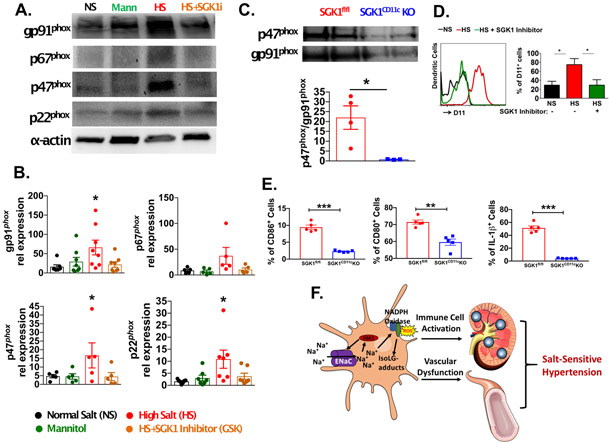Figure 6:
CD11c+ APC SGK1 mediates NADPH oxidase expression and activation in DCs leading to the formation of IsoLG-protein adducts. (A) Western blot showing expression of NADPH oxidase subunits in splenic CD11c+ APCs cultured for 24 hours in either normal salt (NS; 150 mMol/L NaCl), Manntiol (Mann), high salt (HS; 190 mMol/L), or HS + SGK1 inhibitor (HS + SGK1i). (B) Quantification of p22phox, p47phox, p67phox and gp91phox in CD11c+ APCs as determined by densitometry of Western blots. (C) Co-immunoprecipitation studies to define the association of p47phox and gp91phox in SGK1fl/fl controls and SGK1CD11cKO mice after L-NAME/high-salt feeding. (D) Flow cytometry of intracellular staining of IsoLG-protein adducts with D11 antibody in APCs after 24 hours of culture in NS, HS, or HS + SGK1i. (E) Effect of high sodium exposure on the percent of SGK1fl/fl and SGK1CD11cKO cells expressing CD80, CD86 and producing IL-1β (F) Pathway illustrating how high salt may lead to an inflammatory state. SGK1 increases expression of ENaC in antigen presenting DCs. This allows increased sodium entry into DCs. The elevated sodium increases activation and expression of NADPH oxidase which increases production of reactive oxygen species and accumulation of IsoLG-protein adducts. This leads to activation of immune cells which infiltrate the kidney and the vasculature, promoting sodium retention, vascular dysfunction and salt-sensitive hypertension. *p<0.05; **P<0.01; student’s t-test and one-way ANOVA; n=3-8 per group. All data are expressed at mean ± SEM.

